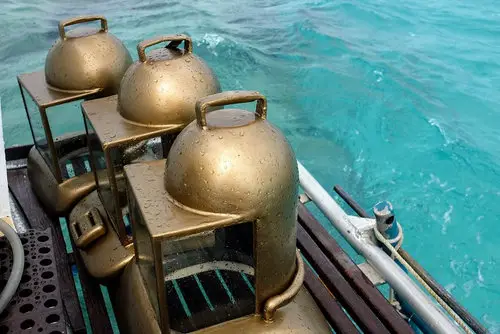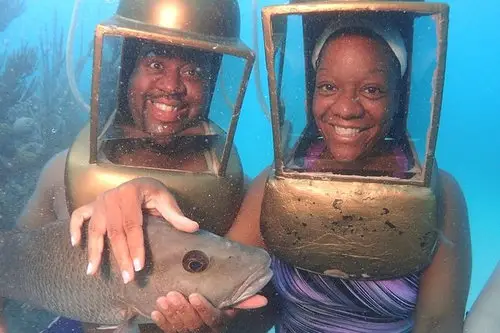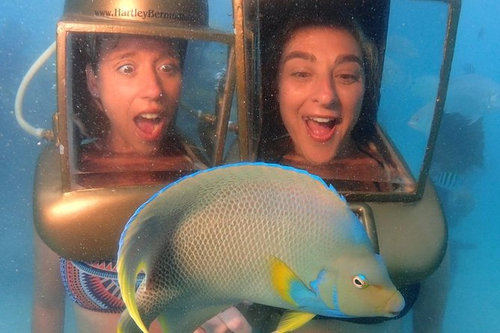Helmet Diving in Bermuda
About Helmet Dive in Bermuda
So you want to see the spectacular underwater life, but unfortunately you are not a good swimmer. You've tried snorkeling, but you end up gulping so much water that you can hardly be comfortable locating a fish. Well, before you resign and settle to a glass-bottom boat ride, consider helmet diving. This is also known as bell diving. There are no lessons or swimming ability required. All you need is just a sense of adventure. This is like an underwater walk on the ocean floor! In fact, if this is the first time you are trying Helmet diving, this could probably be the best walk you have ever taken in your life!
Photo: Peter Burka, flickr, cc by-sa 2.0
So how does it work? You wear a helmet with a glass that you can see through. You can freely breathe inside as fresh air is pumped in through a hose that comes right from above the water level. Inside the helmet your head stays dry and you don't have to worry about water getting in through your nose or mouth. You can even adjust the glasses. The heavy helmet feels weightless under the water. So once your breathing is taken care of, the underwater world is all yours to explore at ease.
The helmet diving operators in Bermuda routinely take visitors from ages 8 to 85, usually on three-hour excursions. However, out of the entire excursion time, the underwater walk lasts only for about 25 to 30 minutes. This is because the operators take small groups under the water by turn.
Here is one of our experiences of helmet diving in Bermuda.
We made our reservation with one of the best dive operators that schedules routine helmet diving in Bermuda by boat. We were taken to an excellent water area close to the western end of the island. In a group of six, we slowly climbed down the ladder until the water was at shoulder level. Paul was our guide. As he placed the helmets over our heads we heard bubbles rising in the water. We slowly stepped down until we touched the sea floor some 12 feet below the water surface.
The helmets, which weigh 14 to 18 pounds above water, felt weightless down here. Paul handed us a long bar that we needed to hold on to. This is to keep our group of six together so the underwater video cameras could film us. The remaining passengers on board watched our underwater walk as they awaited their turns. Paul gave each of us an open mussel. In no time a group of sergeant majors and butterfly fish targeted our offerings.
Photo: Viator/Harley's Undersea Walk
We spotted angelfish, red squirrel fish and a sparkling parrotfish that were following us. They waved their fins in front of our helmet glasses and swiftly swam off as we tried to reach out for them. Paul signed at us that we walk forward. He soon curled his thumb and forefinger to indicate a coral. We saw a sleeping coral that looked like a tree on a winter day.
We noticed another coral that was fully awake and agile. It was greenish and fluffy with tiny flowery heads. It looked like as if it was waiting for some planktons to float by. Planktons are small microscopic sea organisms which some corals feed on.
Paul gave each of us a magnifying glass as he offered a tiny piece of fish to the coral. It quickly grabbed the food with its small tentacles and swallowed it. As we walked along the soft sand, Paul pointed towards another coral, shaking his hand and saying "Ouch!" indicating that it was a stinging coral. Those corals use their stinging abilities to paralyze the planktons.
Photo: Viator/Harley's Undersea Walk
We stopped besides a sponge. Paul pointed towards its breathing holes and sprinkled some sand above them. The sponge exhaled a puff of water and the sand scattered. We spotted a sea cucumber. Paul held it so we could touch its soft skin.
All too soon (in about 25 minutes), it was time to head back to the boat for hot shower and dry towels. After the showers, as we sat on the open deck we learned from the guides that there are two giant hogfish named Theodore and Samantha who love mussels. A few lucky people are able to hand-feed them whenever they show up.
The most rewarding moments for Paul are when he gets amputees and blind people to helmet dive under the water, those who can only dream of diving. On one occasion, a large fish came right into the arms of a blind man who could feel the entire fish with his two hands. As soon as he came out of the water, he was yelling with excitement saying "I saw everything!!". Underwater helmet diving in Bermuda can be a very special experience for those who have vision. It's no different for those who don't.
Well, if you think itís worth considering a helmet dive because this can be a great way to experience Bermuda's marine life, I can help you with the best options.
Top Helmet dive operators in Bermuda
The 40-foot boat leaves from the Mangrove Bay Public Dock in Sandys Parish (it is in the western part of island and near the Royal Naval Dockyard cruise port). There are usually two trips, one in the morning and the other in the afternoon. They usually operate between April to November, and six days a week. The entire tour lasts for about 3.5 hours out of which you get to spend about 30-40 minutes underwater to watch the marine life, take pictures or even video.
Rates by Viator
X CLOSED
The boat operates from the Dockyard on some days of the week. On other days, it leaves from the Flatts Village public dock in Hamilton parish next to the Aquarium.
X CLOSED
The boat leaves from Ordnance island in St. George at the eastern end. They operate from Monday through Friday between April and November.
Check rates and book a Helmet Dive using World's #1 online service (Viator) at low prices.
Rates by Viator
|
 By Raj Bhattacharya By Raj Bhattacharya
Raj, a seasoned travel writer and Bermuda destination expert, has extensive global travel experience. This website reflects his profound insights, garnered over nearly two decades of dedicated findings and research on the island. Raj has assisted countless Bermuda-bound visitors by providing direct, personalized responses to their queries and imparting his wealth of knowledge through this platform. This site serves as an indispensable guide for those seeking informed and reliable insights into Bermuda's treasures.
|
Related Articles
|
Visitors' Reviews and†Comments
Phyllis Sisco (June 2013)
What is usually the earliest scheduled time to go for this? How far from the dockyard since we are taking NCL cruise? We were thinking doing your trip then go to lunch then horseshoe beach. Is that too much in one day even if we are docked for almost 3 days. thanks. Never did this so we are trying to plan accordingly.
Raj (bermuda-attractions.com) June 2013
Hi, Are you planning with Hartley's Undersea Walk (Helmet Diving)? They usually have daily trips at 9:30am and 1:30pm. The entire trip last for about 3 to 4 hours which includes reaching the dive area by boat, dive time (about 25-30 minutes for each group of 6-7 and they usually take up to 24-28 divers in a boat), plus returning. The boat leaves from the small dock near the moongate at Heritage Wharf in dockyard itself. The NCL cruise docks at Heritage Wharf, and so it'll be only few steps walk from the pier.
If you take the morning trip, you can easily visit Horseshoe bay beach after lunch (bus #7 or take the minibus shuttle service). Regards,
|



 By Raj Bhattacharya
By Raj Bhattacharya